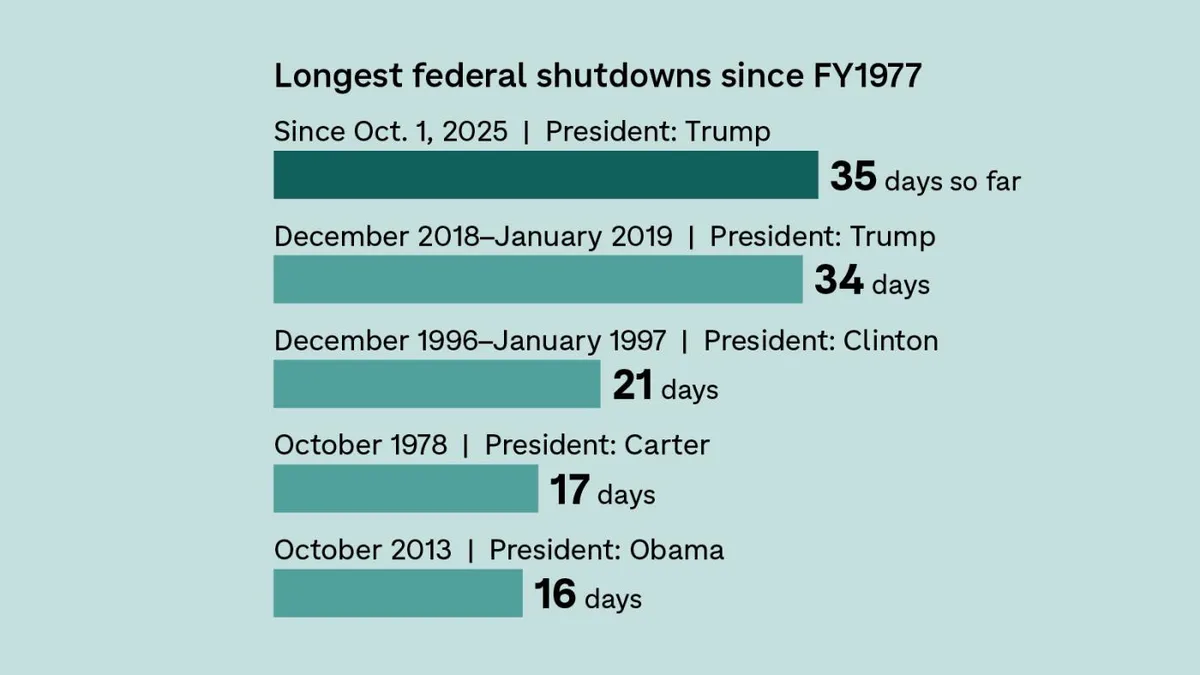
The ongoing government shutdown has officially entered its 36th full day as of Wednesday, making it the longest government shutdown in U.S. history. This unprecedented closure surpasses the previous record set during the most recent shutdown from December 2018 to January 2019 under the Trump administration. That shutdown was primarily triggered by a conflict over funding for President Trump's proposed southern border wall, lasting 35 days and resulting in an estimated $3 billion loss in GDP. The situation escalated to a point where disruptions, including significant delays in air travel, forced Trump and Republican lawmakers to negotiate a compromise.
This current government shutdown began on October 1 after Congress failed to resolve a deadlock over funding negotiations. As we move further into November, there appears to be no end in sight to this stalemate. The Committee for a Responsible Federal Budget reports that since the introduction of the modern budget process in 1976, there have been 20 funding gaps. However, most of these only lasted a few days, with only three shutdowns extending beyond two weeks, all occurring within the last 30 years.
Despite the Republican Party controlling both chambers of Congress, they require a minimum of 60 votes in the Senate to pass any spending bill. This situation has allowed Democrats to leverage their position to advocate for an extension of the Affordable Care Act subsidies, which are set to expire at the end of this year. If these subsidies are not extended, millions of Americans could potentially lose their health insurance coverage. While Republican leaders have expressed a willingness to discuss the subsidies, they insist that talks should only commence after the government reopens.
The ramifications of this prolonged shutdown are being felt acutely across the nation. Over 1 million federal workers are currently working without paychecks, and approximately 600,000 federal employees have been furloughed. Although a law enacted in 2019 guarantees that furloughed workers will receive back pay once the shutdown concludes, recent statements from President Trump have raised concerns about whether this promise will be honored.
Additionally, the shutdown has caused severe disruptions in various sectors. Air traffic control shortages are leading to increased delays and operational challenges at airports nationwide. National parks are scaling back their services, while popular destinations such as Smithsonian museums remain closed to the public. The Internal Revenue Service (IRS) has furloughed nearly half of its workforce, resulting in significant delays in taxpayer services. Furthermore, tens of thousands of low-income children now face potential loss of access to the Head Start program, and federal food and nutrition benefits, including the Supplemental Nutrition Assistance Program (SNAP), ceased over the weekend. This stoppage has sparked a public outcry, prompting pushback from two federal judges.
In response to the mounting pressure, the Trump administration announced plans to restart these food assistance payments, although they will be delayed and may only be issued at half the usual amount. During a recent interview with CBS News, Trump continued to attribute the shutdown to Democratic resistance and urged Senate Republicans to eliminate the filibuster to circumvent Democratic opposition. However, Senate Republicans have dismissed this suggestion. Despite acknowledging his previous involvement in ending the last shutdown, Trump seems less inclined to compromise this time, stating, "I'm not gonna do it by being extorted by the Democrats who have lost their way."